Got Rum? ®

WITH RUM - A NG el’s sHAR e - CIGAR & R UM MU se OF MIXO l OGY - RUM HI s TORIAN
H e AMAZING WOR l D OF A l COHO l - RUM IN TH e N e W s
e IMBIB e R’ s A l MANAC - RUM IN HI s TORY
e s W ee T BU s IN ess OF s UGAR
COOKING
T
TH
TH
March 2024 fro M the grass to your glass, since 2001!





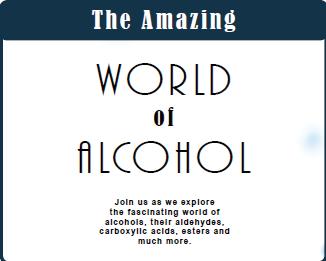
28 10 6 20 g ot r um? March 2024 - 2 32
March 2024
5 From The e di T or
6-9 The Angel’s s h A re - r um r eviews
10-13 C oo K ing wi T h rum
14-19 T he im B i B er ’ s A lm A n AC
20-23 muse o F mi X olog Y
24-25 T he rum universi TY® li B r A r Y
28-31 The rum his T ori A n
32-37 T he A m AZ ing world o F A l C ohol
38-41 rum in his T or Y
42-45 rum in T he news
46-59 T he swee T B usiness o F sug A r
68-71 C ig A r A nd rum PA iring




68 42
c ontents
g ot r um? March 2024 - 3 46



March 2024
e ditor and Publisher: luis@gotrum.com
e xecutive e ditor: margaret@gotrum.com
Cigar and r um: philip@gotrum.com
Angel’s s hare: paul@gotrum.com
r um h istorian: marco@gotrum.com
r um in the n ews: mike@gotrum.com
Cooking with r um: sue@gotrum.com
w ebmaster: web@gotrum.com
d irector of Photography: art@gotrum.com
i f you would like to submit news or press releases, please forward them to: news@gotrum.com
You can download the free electronic version (low-res) of this magazine, or purchase the high resolution printed version at: WWW. gotru M. co M

The printed version of “ g ot r um?” is produced with F s C-certified paper, which means it is from responsibly managed forests and verified recycled sources.
F ron T C over : d istilled s ymmetry inside s P re A d : s ugar, w ater and w ood
Printed in the u s .A. A publication of r um r unner Press, i nc. h utto, Texas 78634 - u s .A.
Got Rum? ®
©
by
um r
Press, i nc.
Tel/Fax +1 (855) rum -T i P s
2024
r
unner
All rights reserved.
F rom T he edi T or Sugar Mill Closures
i ’ve written many times about the challenges faced by sugar mills around the world, and the incredible pace at which they are being forced to close.
This time the impact is much closer to our d istilled s pirits Plant in Texas: the last remaining sugarcane operation in the state is closing after 51 years of operation.
r io g rande valley s ugar g rowers i nc. ( rgsvg ) recently completed their last harvest and milling season, announcing that due to numerous water shortages in the area and to the lack of support from the u . s . s tate d epartment, they are being forced to close their doors after many decades of operation.
o ver the past half-century, rgvsg i nc. employed over 500 full-time and seasonal workers at the mill annually. Additionally, the mill employed over 100 local growers, who serviced up to 40,000 acres of planted sugarcane.
rgvsg has ranked as one of the top 10 producers of raw sugar in the u nited s tates. i t is a member-owned cooperative, comprised of over 126 growers in a three-county area. They processed more than 1.5 million tons of sugarcane annually, producing nearly 160,000 tons of raw sugar and 60,000 tons of molasses.
As you can see, sugar mills play an important role as employers and as suppliers of a commodity that is at the core of many other industries. The world cannot afford to keep losing mills at the current rate, but solutions are not easy to come by.

w hile it is true that well-funded craft distilleries can plant, harvest and mill their own sugarcane, their goal is usually to extract and utilize the fresh cane juice, instead of refining it into crystalized sugar and molasses, which are an essential ingredient for many other businesses.
w e thank the hard workers at rgvsg and at every mill around the world, for doing their best to keep their mills in business.
Cheers!
 l uis Ayala, Editor and Publisher
l uis Ayala, Editor and Publisher

http://www.linkedin.com/in/rumconsultant
do you want to learn more about rum but don’t want to wait until the next issue of “got rum?”? Then join the “rum lovers unite!” group on linkedin for updates, previews, Q&A and exclusive material.
g ot r um? March 2024 - 5

T he A ngel’
s sh A re
by Paul s enft


m y name is Paul s enft - r um r eviewer, Tasting host, Judge and w riter. m y exploration of r ums began by learning to craft Tiki cocktails for friends. i quickly learned that not all rums are created equally and that the uniqueness of the spirit can be as varied as the locales they are from. This inspired me to travel with my wife around the Caribbean, Central America, and u nited s tates visiting distilleries and learning about how each one creates their rums. i have also had the pleasure of learning from bartenders, brand ambassadors, and other enthusiasts from around the world; each one providing their own unique point of view, adding another chapter to the modern story of rum.
The desire to share this information led me to create www. r umJourney.com where i share my experiences and reviews in the hopes that i would inspire others in their own explorations. i t is my wish in the pages of “ g ot r um?” to be your host and provide you with my impressions of rums available in the world market. h opefully my tasting notes will inspire you to try the rums and make your own opinions. The world is full of good rums and the journey is always best experienced with others. Cheers!
o xbow e state r um- r hum l ouisiane 2022
o xbow r um d istillery is in Pointe Coupée, on the banks of the m ississippi r iver, where they grow their sugarcane on fertile oxbow (hence the company’s name). For their r hum l ouisiane product, every fall the distillery harvests their cane and, within hours of harvest, presses the cane and uses the cane juice to create this product. After fermentation, they distill the liquid in small batches using a pot still. The rum is then blended to 45% AB v and bottled without using any additives or sweeteners.
a ppearance
All the bottles in the o xbow line are a standard tall-neck 750-ml design. They provide a good bit of information about their products on the front and back labels. The bottle is sealed with a wooden cap and a plastic cork with a logoed security wrap. The liquid in the bottle and glass is crystal clear. s wirling the liquid creates a medium band that slowly expands, releasing a wave of slow-moving legs before evaporating, leaving a ring of pebbles around the glass.
n ose
w hen i poured the rum into the glass, there was an immediate aroma of freshly cut grass. As the liquid settled, i noticed notes of lemon zest, green grapes, and tangerines.
Palate
The first sip of the rum delivers a good balance of vegetal cane, mineral notes,

and alcohol. Additional sips revealed notes of papaya and funky herbaceous botanical flavors, rounded out by the lemon zest note i found in the aroma. i t is this zest note that dominates and lingers with the mineral notes, creating a long, tart finish.
r eview
i first encountered this rum at the 2023 Tales of the Cocktail, along with their barrel-aged product. o ver the years, i have watched with curiosity as this company has evolved and gone through some ownership changes and rebranding. w hen i spotted it on one of the shelves of a store in Atlanta, i thought it was time to give this rum a proper evaluation and review it for “ g ot r um?”. The r hum l ouisiane product is a vintage product with the year written on the front label. i t will be interesting to see how it changes from year to year, knowing that their goal with this product was to create an agricole-style rum. m y impression is that they did an impressively good job of honoring the rum products made in the French Caribbean and capturing that fresh cane flavor you find in the minimally aged rhums from that region. As far as cocktails are concerned, i enjoyed it in a classic d aiquiri and citrus-based punch and can see where some bartenders could have some fun creating something unique for their bar menus.
Currently, o xbow e state r ums is slowly rolling out in the u s . and is available in a few states. i f you enjoy minimally aged agricole rhums, when you see this rum on the shelves, it is worth picking up and experimenting with.

g ot r um? March 2024 - 7
www.oxbowrumdistillery.com
The A ngel’ s sh A re
by Paul s enft

e quiano l ight r um
s everal years ago, i reviewed the original e quiano expression for “ g ot r um?” magazine. r ecently, i found e quiano l ight in a store in the Atlanta area and had to pick it up for a review. e quiano l ight is a blend of an unaged sugarcane juice-based rum made at g ray’s d istillery in m auritius that is sent to the Foursquare r um distillery in Barbados, where it is blended with minimally aged (three years) molassesbased rum produced at the distillery. i t is brought down to 43% AB v and bottled on the island for distribution. l ike the original, it is a unique blend of African and Caribbean rums created by i nternational r um Ambassador and brand owner i an Burrell.
a ppearance
The bottle uses the same 750-ml bottle design as the original. The front and back of the bottle provide basic information about the rum. The wooden-capped synthetic cork is held to the bottle with a salmon-colored security strip.
The liquid has a pale straw color in the bottle and lightens slightly in the glass. s wirling the liquid creates a razorthin band that slowly thickens and releases a single wave of legs before evaporating.
n ose
The aroma leads with a pleasant note of caramelized vanilla, a bit of citrus zest, fresh cut green apple, sweet cooked pineapple, and light oak tannins, rounded out by an interesting herbaceous grass note.
Palate
The first sip of the rum conditions the mouth in a swirl of toffee, sweet tropical fruit, oak tannins, and alcohol. Additional sips revealed the fruit notes as orange peel, green apples, and cooked pears. s weet vanilla and the oak tannins merge and mingle, creating an interesting low-key pop of pepper and menthol as the wood spices form the lightly sweet finish.
r eview
i remembered really enjoying the original e quiano and the e quiano l ight expression, which were very different in flavor profile and juxtaposed nicely with the aged profile of the other product. w here the original is a sipper, by design, the light release is for making cocktails. The blend of the two rums creates an interesting sipping product but works extremely well with citrus-based cocktails like a m ojito, r um s our, and, of course, a classic d aiquiri.
Considering how much i enjoyed the original, i had high hopes that this rum would meet the standards of that product. w ith its unique versatility and flavor profile, i believe it has in some ways exceeded expectations and rank it highly alongside other rum blends that are designed for cocktails.
g ot r um? March 2024 - 8


www.equianorum.com

w ould you like to see your rum reviewed here?
w e don’t charge fees to review rums. You don’t even have to advertise.
s o...
what are you waiting for???
For more information, please send an email to:
margaret@gotrum.com
g ot r um? March 2024 - 9
COOKING WITH RUM
Bringing the Spirit of the Cane Into the Heart of the Kitchen!
by Chef Susan Whitley

g ot r um? March 2024 - 10

g ot r um? March 2024 - 11

s low c ooker Beef Brisket with a pricot- r um g laze
i ngredients for Brisket r ub:
• ¼ Cup l ight Brown s ugar + 1 Tbsp.
• 1 ½ tsp. s ea s alt
• 1 tsp. s moked Paprika
• 1 tsp. g round Cumin
• 1 tsp. o nion Powder
• 1 tsp. g arlic Powder
• ½ tsp. g round Black Pepper
• ¼ tsp. Cinnamon
i ngredients for Brisket in c rock Pot:
• 1 4 lb. Brisket (fat cap trimmed to 1/3- 1/6 inches)
• 2 g arlic Cloves, minced
• 1 (12 oz.) s tout Beer
• ½ Cup d ark r um
• 1 Tbsp. w orcestershire s auce
• 2 ½ Tbsp. s oy s auce
• 2 tsp. o nion Powder
• ½ tsp. Celery s alt
• ½ tsp. d ried o regano
i ngredients for g laze:
• 1 ¼ C. Apricot Preserves
• ½ C. d ark r um
• 1 Tbsp. s oy s auce
• s alt & Pepper to taste
i nstructions:
1. m ake the rub first by combining 1 tablespoon brown sugar with remaining rub ingredients in a small mixing bowl and set aside.
2. n ow prepare the brisket by scoring the fat on top of the brisket with a paring knife. m assage the rub thoroughly onto A ll sides and slits of the brisket.
3. s et your slow cooker on low heat. Combine the remaining sugar, garlic, stout, rum, w orcestershire, soy sauce, onion powder, celery salt and oregano in a bowl and whisk to combine. Place the rubbed brisket inside the slow cooker,
g ot r um? March 2024 - 12
fatty side facing up. Pour the mixture on the side walls of the slow cooker, not directly on top of brisket. Cover slow cooker with lid and cook on low until the brisket is very tender to touch but still holds its shape, about 9 ½ - 10 ½ hours.
4. w hen the brisket is close to finishing in the crock pot, start making the glaze. i n a small sauce pot, whisk together the preserves, rum and soy sauce. s eason with salt and pepper. Bring to a simmer over medium-high heat. r educe heat to maintain simmer and cook, stir frequently (approximately for 10-15 minutes) until reduced to a glaze-like consistency. r emove from heat and adjust for seasoning with salt and pepper. r eserve about ¼ cup of the glaze, for serving. s et aside.
5. Preheat oven to 400 ° F. w hen brisket is done in slow cooker, remove and transfer it to a large baking dish. Brush the top of the brisket with the glaze and put in oven to bake for 10 minutes. r emove brisket from the oven, brush again with glaze and return it to the oven for an additional 10 minutes, or until caramelized on top.
6. r emove brisket from oven and transfer to a cutting board. Allow to brisket to rest on cutting board for 15 minutes. s lice the brisket to desired thickness and serve with the reserved glaze on the side.






g ot r um? March 2024 - 13
Photo credit: foodnetwork.com

a monthly guide
g ot r um? March 2024 - 14 The i mbiber’s Almanac - The r um u niversity®
Imbiber’s The Almanac
for thirsty explorers looking for new reasons to raise their glasses!
Presented by


March 2024 - 15
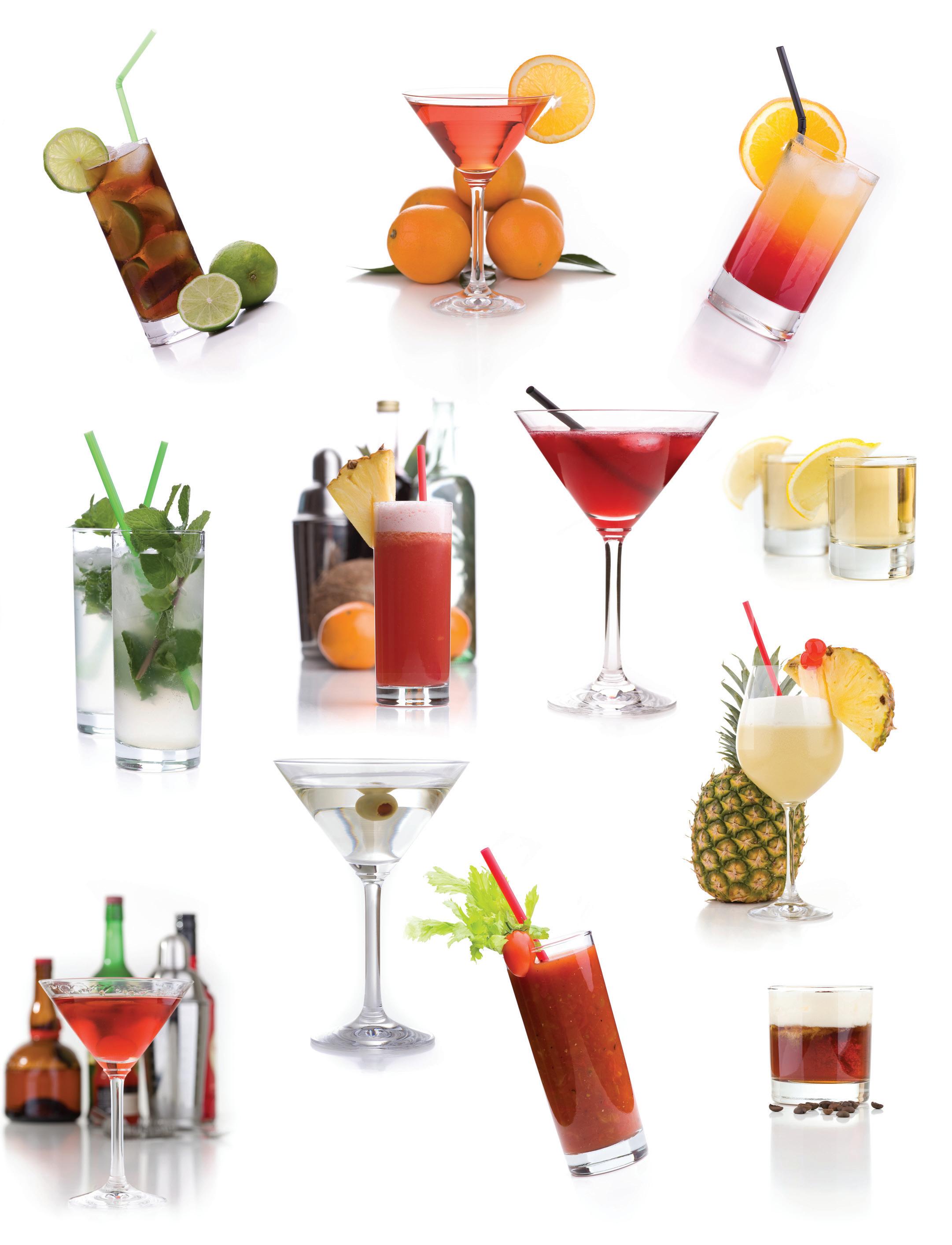

g ot r um? March 2024 - 16
Imbiber’s The Almanac MARCH

Are you looking for festive reasons to raise your glass this month?
h ere are a few of them!
w rite to us at info@gotrum.com if we missed any!
M ar 3 i rish Whiskey Day
M ar 3 n ational Mulled Wine Day
M ar 5 n ational a bsinthe Day
M ar 15 e spresso Martini Day
M ar 17 s t. Patrick’s Day
M ar 20 Bock Beer Day
M ar 27 i nternational Whiskey Day

g ot r um? March 2024 - 17

g ot r um? March 2024 - 18

Imbiber’s The Almanac
Featured Cocktail: r um e spresso m artini (Celebrated on m arch 15)
r um e spresso m artinis have been featured numerous times in this magazine. w e invite you to review Philip’s Cigar & r um Pairings for a few examples.
Below is an excellent recipe from Cris d ehlavi, our m use of m ixology. i t was originally published last month and is an excellent cocktail to celebrate with on m arch 15th.
Beware though, you may crave it throughout the s pring and s ummer!
ru M es P resso M artini
i ngredients:
• 1.5 oz. Aged Jamaican r um
• 1 oz. Coffee l iqueur
• 1.5 oz. e spresso
• Three dashes of o range Bitters
• Three drops s aline
Directions:
s hake well with ice, and strain into a Coupe (or m artini, if you don’t have Coupe) glass. Zest an orange peel over the top and discard. g arnish with three chocolate-covered espresso beans.
g ot r um? March 2024 - 19
the M use of M i X ology
by c ris Dehlavi



h i, my name is Cris d ehlavi, and i have been writing for Got r um? for almost 8 years. For nearly 20 years, i ran a bar program at the prestigious 4- d iamond o hio restaurant “ m at m iranova.” i t was one of the first craft cocktail bars in Columbus and garnered dozens of awards. The restaurant closed in 2020, and it was then that i made a move from being behind the stick to working as Brand e ducator for d iageo h ospitality Partnership.
i have been committed to mentorship my entire professional life and have been one of the leaders of the Cocktail Apprentice Program at Tales of the Cocktail since 2015. i n 2013 i completed the BA r 5- d ay program, and i am happy to announce that i passed my wse T l evel 3 in s pirits this past fall.
o ne of my proudest moments was being inducted into the d ame h all of Fame in 2016. i hope you enjoy my stories about cocktails and rum!

g ot r um? March 2024 - 20
P auline coc K tail
After many years of writing for g ot r um? m agazine, i am always hunting for lesser-known, rare rum cocktails. i t doesn’t mean they aren’t good, either- it just means they didn’t end up in mainstream cocktail recipes. i came across the Pauline Cocktail a few weeks ago and ran home to make it. As with most drinks, it could go onto a cocktail family tree where with just a few tweaks it ends up on a different branch. The Pauline is interesting because it is reminiscent of the classic Daiquiri : r um- l ime- s ugar… but it has lemon instead of lime. (Yes they are different!) i t can also be compared to a c orpse r eviver : g in- Curaçao- l emon- Absinthe… but there is no Curaçao. You could definitely call it a sour, which traditionally has a spirit, lemon, and simple syrup, and you could even consider it a punch.
s o, what exactly is the Pauline and where did it come from? The 1930 book The Savoy , written by the legend h arry c raddock , listed the Pauline as a large “group serve”. h ere is the original recipe:
• 3 glasses r um
• 3 glasses of s weetened lemon juice
• 1 dash Absinthe bitters
• A little nutmeg, grated
• s hake well and strain into a cocktail glass.

g ot r um? March 2024 - 21
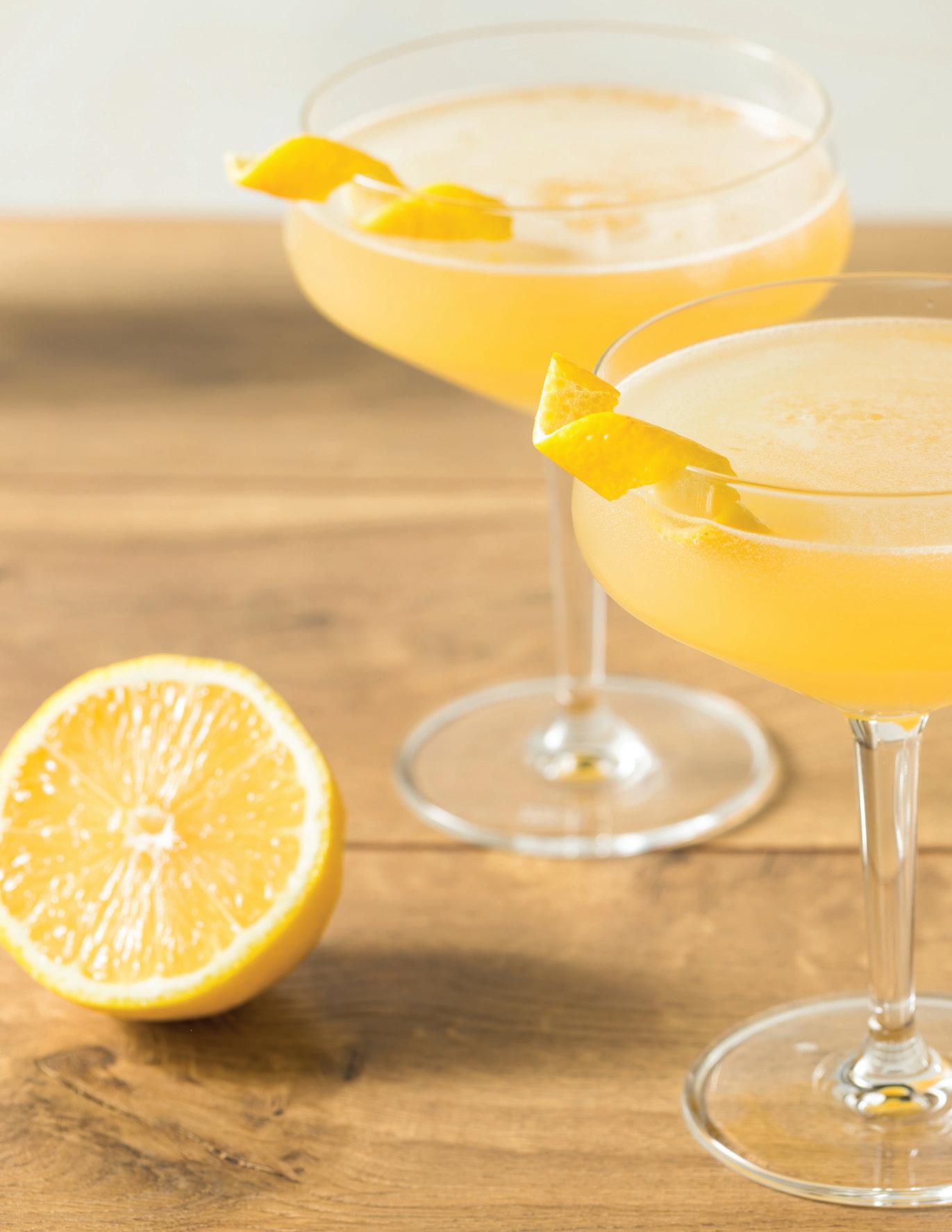
g ot r um? March 2024 - 22

This cocktail is so obscure and hard to recreate. There is no mention of what type of rum (this all depends on what you want your end product to taste like). Three “glasses” don’t tell me much about the size of the glass….but what this recipe does do is suggest that the rum and the sweetened lemon juice are equal parts. This can work. i also love the addition of nutmeg which transforms this light and crisp spring cocktail into something with a little more depth and would also make it very seasonal, from warm weather to cold. Aside from knowing it came from The s avoy, i can find no T hing about this drink’s history. u se your imagination, i suppose. h ere is my personal favorite recipe, having made it a few different ways. e njoy!!
P auline
• 2 oz. u naged r um (your choice of where the rum is coming from as that will certainly make a difference. i used Jamaican in one and Puerto r ican in another and i loved them both. The main thing is you want the rum to shine through but you also don’t want it to overpower the Absinthe)
• .75 oz. l emon Juice
• .75 oz. s imple s yrup
• ⅛ oz. Absinthe
s hake well with ice, and strain into a coupe glass. g rate fresh nutmeg over the top. g arnish with a lemon twist.
Pro t ip : g et creative with this one. Add lavender or herbs. Try using honey syrup instead of sugar syrup. There are a lot of ways to make this recipe unique to you.
g ot r um? March 2024 - 23


LIBRARY
r eviews of books related to sugarcane, milling, fermentation, distillation, aging, blending and other topics related to the production or history of rum.
www. r um u niversity.com
g ot r um? March 2024 - 24
t he s ugarcane c omplex in Brazil: t he r ole of i nnovation in a Dynamic s ector on i ts Path towards s ustainability ( c ontributions to e conomics) 2015th e dition
(Publisher’s r eview) This book offers an in-depth analysis of the Brazilian sugarcane complex with a special focus on technological advances that promote sustainable development. i t first examines the question why sugarcane-based ethanol from Brazil is considered a superior alternative to fossil fuel compared to other biofuels produced on an industrial scale and subsequently analyzes the most dynamic areas within the sugarcane sector with regard to relevant actors, technologies and markets in order to determine if the sector can be considered an innovation system. The empirical research presented here is based on multiple research methods and derives its data from interviews with Brazilian experts of the sugarcane sector and by a thorough literature review. The book will be of special interest to researchers and practitioners interested in understanding the key mechanisms in successful innovation systems that promote a transition towards sustainable development and mobility.
About the Author


After finishing his d iploma in Business Administration, Felix Kaup worked more than four years for several associations and as an international project manager within bioenergy projects in l atin America and s outh Africa. d uring his employment with the Potsdam i nstitute for Climate i mpact r esearch he worked as a researcher on biofuels and wrote his doctoral thesis. For more than eight years Felix Kaup has been working in interdisciplinary and intercultural teams.
Publisher: s pringer; 2015th edition (April 8, 2015)
l anguage: e nglish
h ardcover: 302 pages is B n -10: 3319165828
is B n -13: 978-3319165820
i tem w eight: 12.78 pounds
d imensions: 6.14 x 0.69 x 9.21 inches
g ot r um? March 2024 - 25

g ot r um? March 2024 - 26


your o ne- s top s hop for a ged r ums in Bulk!
• Column- d istilled, Pot- d istilled or Blends
• h igh Congener ( i ncluding h igh e sters), l ow Congener or Blends
• Aged in American or French o ak Barrels
• Aged in r ye w hiskey, Bourbon, Tequila, Armagnac, Port, s herry and w ine Barrels
• s ingle Barrels and s econd Aging/Finish
• d istilled in the us A, Central America, s outh America or in the Caribbean
• o ver 150 m arks/ s tyles Available, plus Custom Blends
• l ow m inimums and Fast Turnaround, w orldwide s hipping www. r umCentral.com
g ot r um? March 2024 - 27
the ru M historian
by m arco Pierini
i was born in 1954 in a little town in Tuscany ( i taly) where i still live. i n my youth, i got a degree in Philosophy in Florence and i studied Political s cience in m adrid, but my real passion has always been h istory and through h istory i have always tried to understand the world, and men. l ife brought me to work in tourism, event organization and vocational training, then, already in my fifties i discovered rum and i fell in love with it.
i have visited distilleries, met rum people, attended rum Festivals and joined the r um Family. i have studied too, because r um is not only a great distillate, it’s a world. Produced in scores of countries, by thousands of companies, with an extraordinary variety of aromas and flavors, it is a fascinating field of studies. i began to understand something about sugarcane, fermentation, distillation, ageing and so on.
s oon, i discovered that rum has also a terrible and rich h istory, made of voyages and conquests, blood and sweat, imperial fleets and revolutions. i soon realized that this h istory deserved to be researched properly and i decided to devote myself to it with all my passion and with the help of the basic scholarly tools i had learnt during my old university years.
i n 2017 i published the book “A meri CA n rum – A s hort h istory of r um in e arly America”
i n 2019 i began to run a Blog: www. therumhistorian.com
i n 2020, with my son Claudio, i have published a new book “F ren C h rum – A h istory 1639-1902”.
i am currently doing new research on the h istory of Cuban r um.

his T or Y o F C u BA n rum
17. i C e in A ho T C oun T r Y
“ m any years later, in front of the firing squad, Colonel Aureliano Buendía would remember that remote afternoon when his father had taken him to know the ice. ... s o much had he insisted that José Arcadio Buendía had paid the thirty reales and led them to the center of the tent where there was a giant with a hairy torso and shaved head, with a copper ring on the nose and a heavy iron chain around the ankle, guarding a pirate chest. w hen uncovered by the giant, the chest let out a glacial breath. i nside there was only a huge transparent block with infinite internal needles which were shattered into colored stars the clarity of twilight. Bewildered, knowing that the children expected an immediate explanation, José Arcadio Buendía dared to murmur:
- i t is the largest diamond in the world.
- n o -corrected the gypsy- i t is i ce”
This is the wonderful incipit of the novel
g ot r um? March 2024 - 28 g ot r um? March 2024 - 28
“ One h undred Years of Solitude ” by g abriel g arcía m arquez, and it gives the idea of the wonder felt by an inhabitant of warm climates, in this case a village in Colombia, the first time he meets ice.
Today we are so used to having ice available at all times, in abundance and at a small cost, that it is difficult to understand what a luxury it was to have ice in the past. For centuries the pleasure of drinking a cool drink in a warm climate was reserved for the rich and powerful few because ice came from afar, had to be transported carefully and laboriously, and then had to be stored carefully so that it did not melt immediately. Younger readers will be amazed, but the presence of a refrigerator in every home is a recent fact. i n my country, i taly, and i think all over e urope, more or less since the 1960s. And i am old enough to remember when, as a child, my uncle used to take me to buy an ice sheet, which we then put into the “icebox” of the house and which served the whole family for days. Anyway, the history of using ice to cool drinks is ancient and complex. i t deserves a serious study that goes beyond my strength and also beyond my current research. s o, i ’ll just try to sort out the information i have found on w ikipedia and other general web sites.
Before mechanical refrigeration systems were introduced, ancient peoples, including the g reeks and r omans, cooled their food with ice transported from the mountains. w ealthy families made use of snow cellars, pits that were dug into the ground and insulated with wood and straw, to store the ice. i n this manner, packed snow and ice could be preserved for months. s tored ice was the principal means of refrigeration until the beginning of the 20th century, and it is still used in some areas.
According to w ikipedia, in modern times
commercial export of natural ice began in 1805, from Boston to the south of the us , the Caribbean and Cuba. l ater, with the arrival of steamships, ice could be transported even further. But the date offered by w ikipedia does not convince me because in the course of my studies on Cuba i found an interesting source dating a few years earlier. h ere it is.
Francisco de Arango y Parreño, the great intellectual and leader of the Cuban s ugar Barons, in the year 1801 wrote for the r eal c onsulado (more or less, r oyal Council) an “ Informe sobre la introducción del hielo ” ( r eport on the introduction of ice). i n this short work, Arango y Parreño wrote: “ i f it is true, as very reliable people say, that the town of Charleston receives from n ew York most of the ice it consumes, it is clear that there is no problem from the same place or closer ones to transport to h avana the ice we need, and it is only necessary in such a case that, as is done everywhere, some wells are built here where the ice can be properly kept and preserved.”
o n 15 o ctober 1801, the g overnor replied “having been informed by the Tribunal del Protomedicato (the m edical Authority) that cold drinks cannot harm public health if used with moderation and at proportionate hours, as well as being useful for medicinal use for diseases originating from rarefaction and blood collimation [ i have no idea what those are], which are so common in hot climates - it was agreed that the r oyal Council would make just one test of this experiment, driving the ice from the most immediate place where it existed, whether national or neutral, so that, according to its result, the most suitable providence could henceforth be taken.”
The decision in Cuba in 1801 was therefore an experiment of which i do not know the sequel, while a Frederic Tudor was maybe the first to capitalize on this new commodity by harvesting ice in n ew
g ot r um? March 2024 - 29
e ngland and shipping it to the southern states as well as the Caribbean islands. At the beginning, Tudor lost thousands of dollars, but eventually turned a profit as he constructed icehouses in Charleston, v irginia and in the Cuban port town of h avana. These icehouses, as well as bet-ter insulated ships, helped to reduce ice wastage and Tudor expanded his ice market to other towns with icehouses, such as n ew o rleans and s avannah. Tu-dor’s success inspired others to get involved in the ice trade and the ice industry grew. s o, by the early 1830s, in the us ice became a mass-market, cheap, com-modity. i n n ew York City, ice consumption increased from 12,000 tons in 1843 to 100,000 tons in 1856. But remember that it was still natural ice, collected in winter and then stored and transported.
The history of artificially produced ice began sometime later. According to the web search results, the first known artificial refrigeration was demonstrated by a w illiam Cullen at the u niversity of g lasgow in 1748. Cullen let ethyl ether boil into a partial vacuum; he did not, however, use the result to any practical purpose. i t seems that the first machines for making ice commercially appeared in the mid-1800s and in the second half of the century spread to all major cities. s ome also appeared in bars. o n this we have a reliable testimony. s amuel h azard made his trip to Cuba in the middle of the 1860s and in his fascinating “ c uba with pen and pencil ”, published in 1870, which i have repeatedly quoted, wrote:
“ l ife, it would be supposed, would be almost insupportable in a climate like that of Cuba without plenty of ice; and fortunately, in h avana and the principal towns of the island there is no lack of it, costing from two to three cents per pound according to the supply; but it was only in 1806 that ice was introduced into the island. At the l ouvre
café they have a most ingenious way of making it, which must be much more economical than buying it and wasting, as is done with us. The decanters are filled with water, which by some process is then frozen in the bottle, forming a solid lozenge-shaped lump of ice, the which, when you ask for ice-water, is brought to you partially melted. You use what is wanted, and it is then taken away, refilled, and refrozen.”
As we know ( s ee the article sug A r , r AC e A nd grow T h i n the d ecember 2022 issue) Cuban economy and society in the 1800s were extremely advanced, but this small bar machine described by h azard was a rarity. i n fact, to make ice you needed big and expensive equipment, so for decades, Cuban bars bought ice from companies specialized in its production.
As i have already said several times, often the best historical sources are those that are such unwittingly. h ere’s another famous example: “You know how it is there early in the morning in h avana with the bums still asleep against the walls of the buildings; before even the ice wagon comes by with ice for the bars?”
n o, sadly i don’t know, i never knew and i ’ll never know, because that h avana doesn’t exist anymore. But beyond the nostalgia for a disappeared world, this wonderful incipit with which e rnest h emingway begins his “ To have and have not ”, published in 1937, (which, truth be told, after this beginning, i did not like very much) tells us that still in the 1930s, the bars in h avana did not have ice machines, but they bought the ice they consumed from specialized firms.
The arrival of ice had a huge impact on rum consumption, especially of Cuban rum. i t was lighter, with few congeners, more drinkable and versatile, and
g ot r um? March 2024 -
30
perfect for cocktails. This new kind of rum, which was born and flourished alongside the large-scale spread of ice, mixed well with almost everything.
i am not an expert in cocktails, but between 1800 and 1900, between the w ar of i n-dependence and the American military occupation, the great, classic Cuban cocktails were born: d aiquiri, m ojito and Cuba l ibre. There are many stories about the origin of these famous, long-lasting Cuban cocktails, and all, it seems to me, have to do with the presence of American technicians and soldiers on the island in the years around 1900, between the beginning of the s econd w ar of i ndependence and the first years of the new republic. This is not surprising, because Americans’ passion for cocktails is ancient, dating back to the colonial era (see my article B e F ore J err Y T hom A s in the April 2016 issue). Then came Jerry Thomas. For his pioneering work in the popularization of cocktails he is considered the father of the art of mixing American cocktails; in addition to writing the first recipe book on cocktails in 1862, the creativity and spectacularity of his work defined the image of the barman as a creative professional. w ith him, mixology became fashionable, and it has remained so until today.
At this point i have to make a confession: i don’t like cocktails very much. From time to time, i like to drink a good d aiquiri, especially in the warm summer days of my country, on the beach, preferably after (and not before) a good seafood meal. And, more rarely, a T- Punch as an aperitif. But nothing more than that.
n ot only do i not drink cocktails, i do not feel their charm, neither of the product itself, nor of the many stories around them. m oreover, in so much modern mixology i see an excess of
research, with cocktails that seem to me to be meant to amaze, rather than to please; to be seen, rather than drunk. As if the bartender should be appreciated for his art in itself, for his imagination, creativity etc. rather than for the quality of the cocktail produced. And often, i ’m sorry, but i have to say it, i ’ve seen famous bartenders make very complicated (and, of course, very expensive) cocktails, using low quality, cheap, rum as alcoholic base. i n short, the cocktail world is not my cup of tea. And since i like to do research and write about what interests me, i won’t write much about cocktails in my articles. But never fear, the world is full of good books dedicated to cocktails. Among the many, specifically referring to Cuba, i would recommend the book by Jared Brown and Anistasia m iller “ Spirit of the c ane. The Story of c uban r um ” 2017, and “a nd a Bottle of r um: a h istory of the New World in Ten c ocktails ” by w ayne Curtis of which i have read the 2006 edition.
i n conclusion, Cuban rum owes an important part of its success to ice.
l ater, with the help of Prohibition in the us and tourism, r on Lígero and cocktails were among the fundamental components in the construction of the myth of h avana and of all Cuba, seen by many Americans (and not only) as a true Pleasure i sland. w e will get back to that.
i n addition, Cuban light rum also represented a model and similar rums began to be produced in many other s panish-speaking countries of l atin America (but not in Brazil), creating what many call s panish s tyle r um, which today includes some of the most successful premium rums in the world.
m arco Pierini
g ot r um? March 2024 - 31

Presented by
g ot r um? March 2024 - 32
The Amazing
WORLD
ALCOHOL of
Join us as we explore the fascinating world of alcohols, their aldehydes, carboxylic acids, esters and much more.


g ot r um? March 2024 - 33

The Amazing
WORLD ALCOHOL of
Definition
The term a lcohol , refers to any of a class of organic compounds characterized by one or more hydroxyl (―OH) groups attached to a carbon atom of an alkyl group (hydrocarbon chain).
Alcohols may be considered as organic derivatives of water ( h 2 o ) in which one of the hydrogen atoms has been replaced by an alkyl group, typically represented by r in organic structures. For example, in ethanol (or ethyl alcohol) the alkyl group is the ethyl group, ―CH2CH3.
Alcohols are among the most common organic compounds. They are used as sweeteners and in making perfumes, are valuable intermediates in the synthesis of other compounds, and are among the most abundantly produced organic chemicals in industry. Perhaps the two best-known alcohols are ethanol and methanol (or methyl alcohol). e thanol is used in toiletries, pharmaceuticals, and fuels, and it is used to sterilize hospital instruments. i t is, moreover, the alcohol in alcoholic beverages. The anesthetic ether is also made from ethanol. m ethanol is used as a solvent, as a raw material for the manufacture of formaldehyde and special resins, in special fuels, in antifreeze, and for cleaning metals.
c lassifications
Alcohols may be classified as primary, secondary, or tertiary, according to which carbon of the alkyl group is bonded to the hydroxyl group. m ost alcohols are
colorless liquids or solids at room temperature. Alcohols of low molecular weight are highly soluble in water; with increasing molecular weight, they become less soluble in water, and their boiling points, vapour pressures, densities, and viscosities increase.
Another way of classifying alcohols is based on which carbon atom is bonded to the hydroxyl group. i f this carbon is primary (1°, bonded to only one other carbon atom), the compound is a primary alcohol. A secondary alcohol has the hydroxyl group on a secondary (2°) carbon atom, which is bonded to two other carbon atoms. s imilarly, a tertiary alcohol has the hydroxyl group on a tertiary (3°) carbon atom, which is bonded to three other carbons. Alcohols are referred to as allylic or benzylic if the hydroxyl group is bonded to an allylic carbon atom (adjacent to a C=C double bond) or a benzylic carbon atom (next to a benzene ring), respectively.
n omenclature
As with other types of organic compounds, alcohols are named by both formal and common systems. The most generally applicable system was adopted at a meeting of the i nternational u nion of Pure and Applied Chemistry ( iu PAC) in Paris in 1957. u sing the iu PAC system, the name for an alcohol uses the -ol suffix with the name of the parent alkane, together with a number to give the location of the hydroxyl group. The rules are summarized in a three-step procedure:
1. n ame the longest carbon chain that contains the carbon atom bearing the ―OH group. Drop the final -e from the alkane name, and add the suffix -ol.
2. n umber the longest carbon chain starting at the end nearest the oh group, and use the appropriate number, if necessary, to indicate the position of the ―OH group.
g ot r um? March 2024 - 34
3. n ame the substituents, and give their numbers as for an alkane or alkene.
The example on the right has a longest chain of six carbon atoms, so the root name is hexanol. The ―OH group is on the third carbon atom, which is indicated by the name 3-hexanol. There is a methyl group on carbon 3 and a chlorine atom on carbon 2. The complete iu PAC name is 2-chloro-3-methyl-3-hexanol . The prefix cyclo- is used for alcohols with cyclic alkyl groups. The hydroxyl group is assumed to be on carbon 1, and the ring is numbered in the direction to give the lowest possible numbers to the other substituents, as in, for example, 2,2-dimethylcyclopentanol.
c ommon n ames


The common name of an alcohol combines the name of the alkyl group with the word alcohol. i f the alkyl group is complex, the common name becomes awkward and the iu PAC name should be used. Common names often incorporate obsolete terms in the naming of the alkyl group; for example, amyl is frequently used instead of pentyl for a five-carbon chain.
Physical Properties
m ost of the common alcohols are colorless liquids at room temperature. m ethyl alcohol, ethyl alcohol, and isopropyl alcohol are free-flowing liquids with fruity aromas. The higher alcohols—those containing 4 to 10 carbon atoms—are somewhat viscous, or oily, and they have heavier fruity odors. s ome of the highly branched alcohols and many alcohols containing more than 12 carbon atoms are solids at room temperature.

g ot r um? March 2024 - 35

The Amazing
WORLD ALCOHOL of
f eatured a lcohol:
Propanol (1-Propanol/2-Propanol)
a ldehyde formed:
Propionaldehyde
c arboxylic acid formed :
Propionic Acid
e ster formed when reacting with itself:
Propyl Propionate, aka Propionic Acid Propyl e ster
1-Propanol (also known as propan-1-ol , propanol , n-propyl alcohol ) is a primary alcohol with the formula C h 3C h 2C h 2 oh and sometimes represented as Pr oh or n-Pr oh i t is a colourless liquid and an isomer of 2-propanol. i t is formed naturally in small amounts during many fermentation processes and used as a solvent in the pharmaceutical industry, mainly for resins and cellulose esters, and, sometimes, as a disinfecting agent.
2-Propanol (also known as isopropyl alcohol , propan-2-ol and isopropanol ) is a colorless, flammable organic compound with a pungent alcoholic odor. i t is a secondary alcohol with the same formula as 1-Propanol. i t is used in the manufacture of a wide variety of industrial and household chemicals and is a common ingredient in products such as antiseptics, disinfectants, hand sanitizer and detergents. m ore than a million tonnes are produced worldwide annually.
g ot r um? March 2024 - 36

toxicity
1-Propanol is thought to be similar to ethanol in its effects on the human body, but 2–4 times more potent according to a study conducted on rabbits. m any toxicology studies find oral acute ld 50 ranging from 1.9 g/kg to 6.5 g/kg (compared to 7.06 g/kg for ethanol).
i t is metabolized into propionic acid.
e ffects include


alcoholic intoxication and high anion gap metabolic acidosis. As of 2011, one case of lethal poisoning was reported following oral ingestion of 500m l of 1-propanol. d ue to lack of long term data, the carcinogenicity of 1-propanol in human beings is unknown.
a roma
• Propionaldehyde is often described as having an overwhelming or suffocating “fruity” smell.
• The scent of propyl propionate is described as a chemically-tinged pineapple or pear.

l imit in Beverages
As a normally-occurring congener formed during fermentation, the F d A allows the presence of propanol, especially its esters, in food and beverage products, in limited quantities.
g ot r um? March 2024 - 37

g ot r um? March 2024 - 38
RUM IN

MARCH


g ot r um? March 2024 - 39

March Through The Years
g ot r um? March 2024 - 40
1484 - Columbus asks João II of Portugal to back him in a westward voyage to the Indies, but João rejects the request..
1675 - Grain crop failure in England leads to a shortage of grain, limiting gin production. As a consequence, rum gains popularity in the English market.
1733 colonists, imported
1484
1534 1584
1634
1684

g ot r um? March 2024 - 41
1733 - The Molasses Act is passed by Parliament to tax British colonists, imposing heavy duties on molasses, sugar and rum imported from non-British West-Indian islands. At this time, the average American consumes 3.75 gallons of rum per year.
1802 - The world’s first beet sugar factory goes into production but soon runs deep in debt.
1807 - Slave trade is outlawed by Britain.
1814 - French beet sugar production declines sharply as imports of cane sugar resume and undercut Prices.
1852 - Prohibition laws are adopted by Massachusetts, Vermont, and Louisiana.
1856 - Cessation of letters of marque at the Convention of Paris is the first step to the abolition of privateering.
1917 - United States purchases the Virgin Islands from Denmark.
1734
1784
1834
1884
r u M in the ne W s
by m ike Kunetka


These are the most recent and noteworthy headlines in the rum industry. i f you want us to share your news with our readers, please send me an email to: m ike@gotrum.com.
Pin d rop r um announced the launch of its ultrapremium rum, setting the stage for a new sipping experience in the u nited s tates. h ailing from h arbour i sland in the Bahamas (known as a “pin drop’’ of a place by locals and visitors given its small size and position in the l ucayan archipelago), Pin d rop r um is a sophisticated, character-rich spirit with a captivating tropical palate. The small batch rum, which is blended and bottled by hand, will instantly transport one to the island’s easygoing atmosphere, picturesque pink sandy beaches and sun-drenched shores. Founded in 2018, Pin d rop r um was created by a collective of creators and friends: i thalia Johnson, Toby Tyler and Joe e lison, who infused the heart of their idyllic home and the rich history of the Bahamas into a unique spirit. The idea for Pin d rop r um was born around i thalia’s kitchen table. h er vision was a spirit that reflected her roots and paid homage to her tightknit community. i thalia enlisted Toby’s experience as a master blender and Joe’s island connections to produce a new style of rum. The result was an instant hit, and amassed a passionate following amongst locals. Pin d rop r um is a blend of 10 and 12-year-old Caribbean rums, pot-and-column stilled and aged in
g ot r um? March 2024 - 42
P in D ro P ru M
bourbon white oak barrels. Pin d rop’s exceptional beauty and quality captured the attention of the Bronfman family, leading to their decision to partner with the team to introduce it to the u s w ith Aaron Bronfman at the helm, and with his father e dgar Bronfman Jr.’s (the former C eo of The s eagram Company l td.) guidance from the wings, the family’s unparalleled industry tenure and legacy will surely position Pin d rop r um as a rum that stands the test of time. “The spirits industry is entering a new era of exploration, which is leading to heightened interest in the rum category and its versatility. w ith the arrival of the r um r enaissance and fans embracing the spirit like never before, Pin d rop r um offers a unique style to experience ultra-premium rum from an unlikely place,” said Aaron Bronfman, C eo of Pin d rop r um. “Pin d rop r um was created as an ode to h arbour i sland and its culture, which continue to inspire us on this journey,” Co-Founder, i thalia Johnson, added. www.pindroprum.com.
ten to one
l ast m onth, Ten To o ne introduced its new Five o rigin s elect, the latest addition to its portfolio of award- winning pan- Caribbean rums. The Five o rigin s elect is an exceptional blend of rums aged up to 15 Years, highlighted by the inclusion of a truly remarkable, 11- to 15-year-old g uyanese rum distilled on the famed 250-year-old Port m ourant d ouble w ooden Pot s till, the only one of its kind still in operation. Brought together masterfully alongside signature rums from Trinidad, Barbados, d ominican r epublic, and Jamaica, and bottled at 92 proof, this expression produces a bold and memorable sipping. https://www.tentoonerum.com/
rolling stones crossfire hurricane ru M
Crossfire h urricane r um, the signature rum by The r olling s tones, announced today that it has signed a national distribution agreement with s outhern g lazer’s w ine & s pirits. Born from a pioneering partnership with u niversal m usic g roup and s ocio v entures, Crossfire h urricane r um will first enter the Florida and California markets with s outhern g lazer’s later this month, followed by a nationwide rollout. Crossfire h urricane’s proprietary blend of Caribbean rums from Jamaica, Barbados, and the d ominican r epublic is a fusion of three distinct rum-making traditions, creating a harmonious blend that seamlessly integrates time-honored distillation methods with contemporary flair. This blend, a convergence of history, culture, and innovation, represents a distilled essence of the Caribbean’s finest rummaking legacies. Following Crossfire h urricane’s debut in n ovember 2023, which coincided with the legendary band’s “ h ackney d iamonds” album launch and 2024 tour announcement, the rum has delivered record-setting sales online. o verseeing the company, John Fincher, Partner at s ocio v entures and Co-Founder of Crossfire h urricane, has assembled a powerhouse leadership team built
of top professionals from the spirits and beverage industry, including Kyle r ivera and r yan s tender are leading sales and marketing, respectively.
“ o ur mission is to deliver a premium rum brand that is world-class. Through our relationship with s outhern g lazer’s, we will now make Crossfire h urricane available across the country, ensuring that aficionados and rock & roll fans everywhere can savor the experience and enjoy the band’s legacy for future lifetimes” said John Fincher, s ocio v entures Partner and Co-founder of Crossfire h urricane. m ark Chaplin, s enior v ice President, s ales & m arketing for s outhern g lazer’s w ine & s pirits, added “ g rowing demand for premium rums makes it an exciting time to enter the category. w e’re thrilled to bring Crossfire h urricane by the r olling s tones into our portfolio and to introduce the brand to our national network of trade and retail partners.” https://www.crossfirehurricane.com/, www.southernglazers.com
D ro P W or K s D istillery
d rop w orks is one of the largest rum distilleries in the u nited Kingdom and one of the most innovative. m aster d istiller s haun s mith has developed his own w ild Trinity Yeast, a blend of three yeast strains living together symbiotically. This is used in all of their rums to create the unique, funky flavors that is becoming the d rop w orks signature. h is latest offering is s pice d rop, a spiced rum created without any added spices. s haun wanted to prove that you can get all of the flavor you need naturally, without adding ‘spices’ or flavorings. i t is a molasses-based rum, fermented for 5 to 7 days, distilled on a column still and flash aged with charred heavily French and American oak chips. o ther products include Clear d rop, d ark d rop and Funk d rop. Funk d rop is made from sugar cane honey with the addition of molasses-based “dunder”, fermented for seven days and distilled on their d ouble r etort still. i f you want more funk, you can visit their distillery in w elbeck, n ottinghamshire, in the heart of Britain, and buy a bottle of their limited release, s uper Funk, which is fermented for an entire month. A longer maturation period pushes the ester count to the highest seen in any of their d rops, coming it at 930 esters. d rop w orks offers two standard tours, a 60-minute Basic d istillery Tour and a more technical, 90-minute m eet the d istiller Tour. https://dropworks.co.uk/
B ush W ac K er ru M crea M
Bushwacker s pirits’ Bushwacker r um Cream is honored to be recognized by the wsw A Tasting Competition two years in a row, following up last year’s g old m edal with a 2024 s ilver m edal in the Cream/ d airy l iqueur Category. Co-founders of Bushwacker s pirits, Carter e chols and m ichael s mith explain, “As an emerging brand to be consistently recognized by organizations like wsw A, speaks volumes about the quality of our product, and each award is a real testament to our team at Bushwacker s pirits.” e chols and s mith
g ot r um? March 2024 - 43
started bottling Bushwackers back in 2020, but the history of the famous cocktail dates back to 1975. i n the s pring of that year, Tom Brokamp was working as the manager of the s hip’s s tore in s apphire v illage on s t. Thomas in the v irgin i slands and Angie Conigliaro was the bartender. Tom Brokamp recalls
“The concoction was originally thrown together by Angie at my suggestion as a tropical variation on the w hite r ussian. h ad it not been for Angie’s single-handed efforts, the drink would have soon been forgotten in a blurry hangover. n ot yet earning a name, Angie pushed it on anyone and everyone for weeks as a creamy, kick-butt sort of Pina Colada drink.
After she finalized the recipe a few weeks later and during a particularly slow evening, two gentlemen wandered into the bar with their large dog. They were very proud of their pet which i believe was an Afghan h ound. These two fellows immediately fell in love with Angie’s concoction, and the few people in s apphire v illage at the time fell in love with the dog. The dog’s name was Bushwack, and Angie suggested that the new drink share his name.” By the end of 1975, the Bushwack had spread throughout the islands and had also made its way to Florida via visiting bartenders who fell in love with it. o ver the next 45 years, the drink exploded in popularity throughout the s outheastern u nited s tates (and particularly in the panhandle of Florida) with many bars coming up with new recipes of their own. w hen asked what he thought of the different recipes, Tom replied “ i know the drink has been tweaked continually over the years and that is just fine. h ow you enjoy it is what is most important.” https://www.bushwackerspirits.com/
D on the B eachco MB er
The long-awaited opening of the first new d on the Beachcomber restaurant has happened. Polynesian/Tiki aficionados can now visit the new location at 15015 m adeira w ay, s uite 100, m adeira Beach, Florida, a small city on the g ulf of m exico in Pinellas County, between s t. Petersburg and Clearwater. Tiki website, The Atomic g rog, reported that architect Jack Bodziak, a longtime s outhwest Florida residential and commercial expert over saw the project. s outhern California artist d aniel “Tiki d iablo” g allardo was the stylistic visionary for this restaurant and all of the upcoming d on the Beachcomber locations. The menu includes a collection of Polynesian starters, handheld items (tacos, sandwiches and burgers), salads, entrees and, some twenty-plus famous d on the Beachcomber drinks. Beer, wine and mocktails are also available. https://donbeachcomber.com/
renega D e ru M D istillery
n estled on the north eastern coast of the island of g renada, enveloped by cane fields on all sides,
is the modern r enegade r um d istillery. n ow you can experience everything they do from farm to bottle: from harvest to milling, to fermentation, distillation and finally maturation. This is a proper, all-access tour, nothing hidden, nothing off-limits, and all tricky questions not only welcomed but actively encouraged. All topped off by a proper tasting of natural cane rum.
Arriving at the site, you’ll be welcomed by a sea of sugarcane, and at its heart, you will find one of the rum industry’s most innovative and technologically advanced distillery. You will commence your exploration of the extraordinary set up that facilitates the creation of our terroirdriven, pure cane juice rum by walking through the entirety of the production process from cane to cask. u pon completion of the tour, you’ll have no doubt worked up a thirst, so to finish your visit you will get to taste the fruits of their labor and experience r enegade r um for yourself!
https://renegaderum.com/
el D ora D o
i n a recent, very brief Facebook post, e l d orado posted: “ i ntroducing the new e l d orado h igh e ster Blend - a combination of our exclusive, neverbefore-released h igh e ster r um distilled on our John d ore d ouble r etort Copper Pot s till and the l a Bonne i ntention ( l B i ) marque from the French s avalle s till. Available in select us s tates and g uyana.” u nfortunately, the e l d orado website did not offer any additional information, as the latest ‘news’ was from 2019. l uckly, i found 88 Bamboo, a website that calls itself “Asia’s Freshest d rinks Companion”. From that website i learned that this is the first of nine planned expressions that will showcase the vast range of rum styles that the distillery can produce on the its fourteen heirloom stills. As the Facebook teaser indicated, this offering is a blend of two marques distilled in 2012 on two different stills. The high-ester marque was distilled on the John d ore d ouble r etort Pot s till that has been in use since the 1950s. For this new marque, dhe ( d iamond h igh e ster), e l d orado says that fermentation took place over months and distillation was done at a slow rate with high reflux, thereby producing ester levels in excess of 1,500 g/h l . The second marque, l B i ( l a Bonne i ntention), was produced using the French s avalle m ulti-Column s till, which was first created in the 18th Century and named after the l a Bonne i ntention e state at the e ast Coast of d emerara. Thanks to the folks at 88 Bamboo for filling in the details. https://theeldoradorum.com/, https://88bamboo.co/
ha M ilton ru M s
The latest e d h amilton blend was crafted and bottled specifically for s pike’s Breezeway Cocktail h our, a highly regarded YouTube show with a passionate audience of tiki and home bartender enthusiasts. Building on his successful career
g ot r um? March 2024 - 44
as a commercial photographer, designer and musician with an interest in tiki culture, s pike began his Breezeway Cocktail h our on YouTube during the pandemic to put his video production talents to work exploring the world of tiki culture while offering some entertainment relief at a time when many people were trying to perfect their own home bartending skills. w ith more than a hundred and fifty shows online, s pike has built a loyal following for the Breezeway Cocktail h our, highlighting better rum cocktails and establishing himself as a trusted voice in the industry. After several appearances on the show, e d agreed to work with s pike and his audience to blend a rum that would add another dimension to daiquiris, long drinks and the home bar. Blending his Jamaican Pot s till Blonde and w hite s tache, at 42.5% AB v , the Breezeway Blend has a slight straw color and notes of ripe banana and tropical fruit on the palate leading to a clean smooth finish, the signature of h amilton rums. https:// www.caribbean-spirits.com/, https://www.youtube. com/@BreezewayCocktail h our
ca P tain M organ
Just in time for the warmer months ahead, Captain m organ is officially introducing its newest readyto-drink lineup, Captain m organ s liced. Captain m organ s liced is a line of cocktail-inspired malt beverages with an exciting range that goes all-in on flavor and adventure. Yes, you read that right: cocktail-inspired malt beverages! “ w e didn’t just want to introduce another new canned drink. w e wanted to slice through the ordinary with an offering that compliments the adventurous spirit of our consumers,” said l aura m erritt, C mo , d iageo Beer Company. “Captain m organ has always been known and loved for its bold flavor, and we’re excited to shake up the category and introduce Captain m organ s liced to the world.” Captain m organ s liced offers four delicious malt-based flavors inspired by classic cocktails that will take your taste buds on an adventure: Pineapple d aiquiri s tyle Beverage, s trawberry m argarita s tyle Beverage, Passionfruit h urricane s tyle Beverage and m ango m ai Tai s tyle Beverage. www.Captain m organ.com
K lyr ru M
K lY r r um, a super-premium 100% Americanmade crystal rum, is poised to become a breakout brand as it builds its presence throughout the mid-Atlantic region and amps up its investment in sales and marketing. l aunched in 2021, K lY r r um has experienced strong growth and increased demand in its home state of Pennsylvania and select states up and down the eastern seaboard and now sets its sights on further expansion.
“This is an exciting time for K lY r as we continue to roll out to additional markets and cultivate a passionate following for the brand,” said Keith Krem, C oo of K lY r r um. “ w hat began as an idea of producing a highly versatile, crystal rum 100%
handcrafted in the u s . that possesses the purity of a vodka, yet retains its character as a rum has led to the creation of an exceptional smooth spirit that uniquely meets the needs of today’s consumers. w hen canvassing the marketplace along with studying consumer trends, we saw a void where we believed we could introduce a cleaner, more refined, sugar-free rum that would offer a refreshing alternative from all of the other more-sugary rums out there,” Krem said. “The taste of K lY r is clean and crisp, featuring a blend of the purest brown sugar mixed with clean sugar cane to keep the sophisticated, traditional rum character flavors in and the harsh flavors out. K lY r r um can be enjoyed neat, with a simple mixer like tonic and lime slice or as a classic American cocktail. o ur portfolio also features ready-to-serve K lY r canned cocktails featuring a variety of flavors with a single serve calorie count ranging from 99 to 190 calories,” he added. K lY r r um is distilled 12 times and filtered 18 times and sources crystal clear water from some of the best quality, natural aquifers in central Pennsylvania, achieving higher levels of clarity and purity through reverse osmosis. After what seemed like an infinite number of test batches from l exi Close, the g en Z head distiller for K lY r r um, she and her team fine-tuned the perfect ratio of refined sugar, pristine water along with a bespoke yeast with purity as their guide and smoothness as the desired outcomehttps://klyrrum.com/
rhu M B ar B ancourt
Caribbean n ational w eekly reported that the tranquility surrounding the iconic r hum Barbancourt distillery has been shattered by the tumultuous grip of gang warfare. i n a recent escalation of violence, at least 19 acres of sugarcane fields were engulfed in flames, casualties of a fierce territorial dispute among rival gangs. The blaze, a stark reminder of the perils haunting h aiti’s economic landscape, threatens to cast a shadow over one of the nation’s most cherished exports, its renowned rum. The scorched fields, a sprawling expanse equivalent to more than four soccer fields, bore the brunt of the conflict. h owever, officials from Barbancourt assured the public that the conflagration, while devastating, would not impede the company’s production capabilities. The company’s foundation, however, said it would temporarily stop distributing free potable water, providing medical care, and offering the use of football fields and basketball courts to protect the safety of its employees. As h aiti grapples with the specter of gang violence, the nation is further destabilized by political upheaval. r ecent demonstrations, characterized by fervent calls for the resignation of Prime m inister Ariel h enry, have erupted into violent confrontations. https://barbancourt.com/
g ot r um? March 2024 - 45
The Sweet Business of Sugar

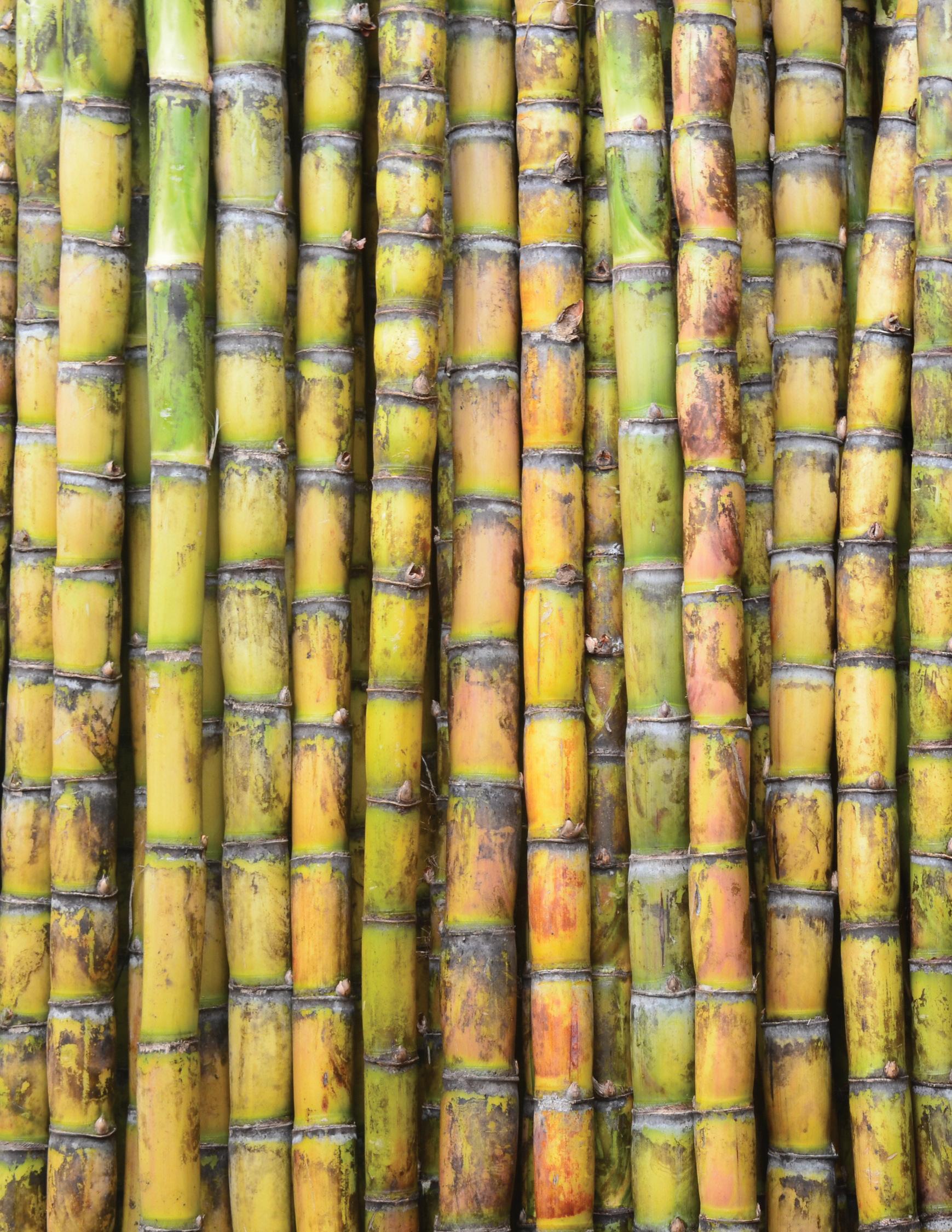

g ot r um? March 2024 - 46
Brazil
r egardless of distillation equipment, fermentation method, aging or blending techniques, all rum producers have one thing in common: sugarcane
w ithout sugarcane we would not have sugar mills, countless farmers would not have a profitable crop and we would not have rum!


g ot r um? March 2024 - 47
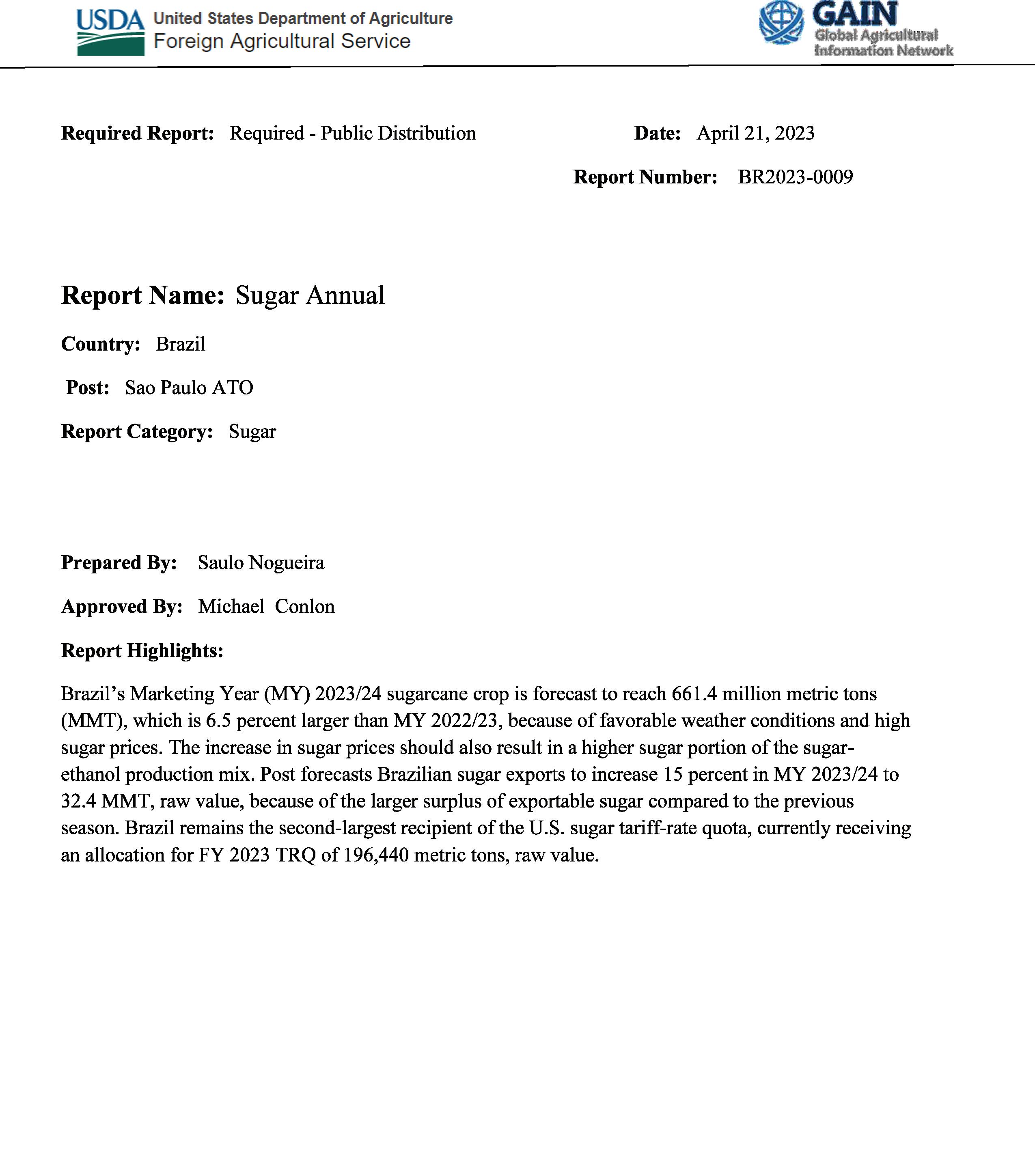
g ot r um? March 2024 - 48

g ot r um? March 2024 - 49

g ot r um? March 2024 - 50

g ot r um? March 2024 - 51
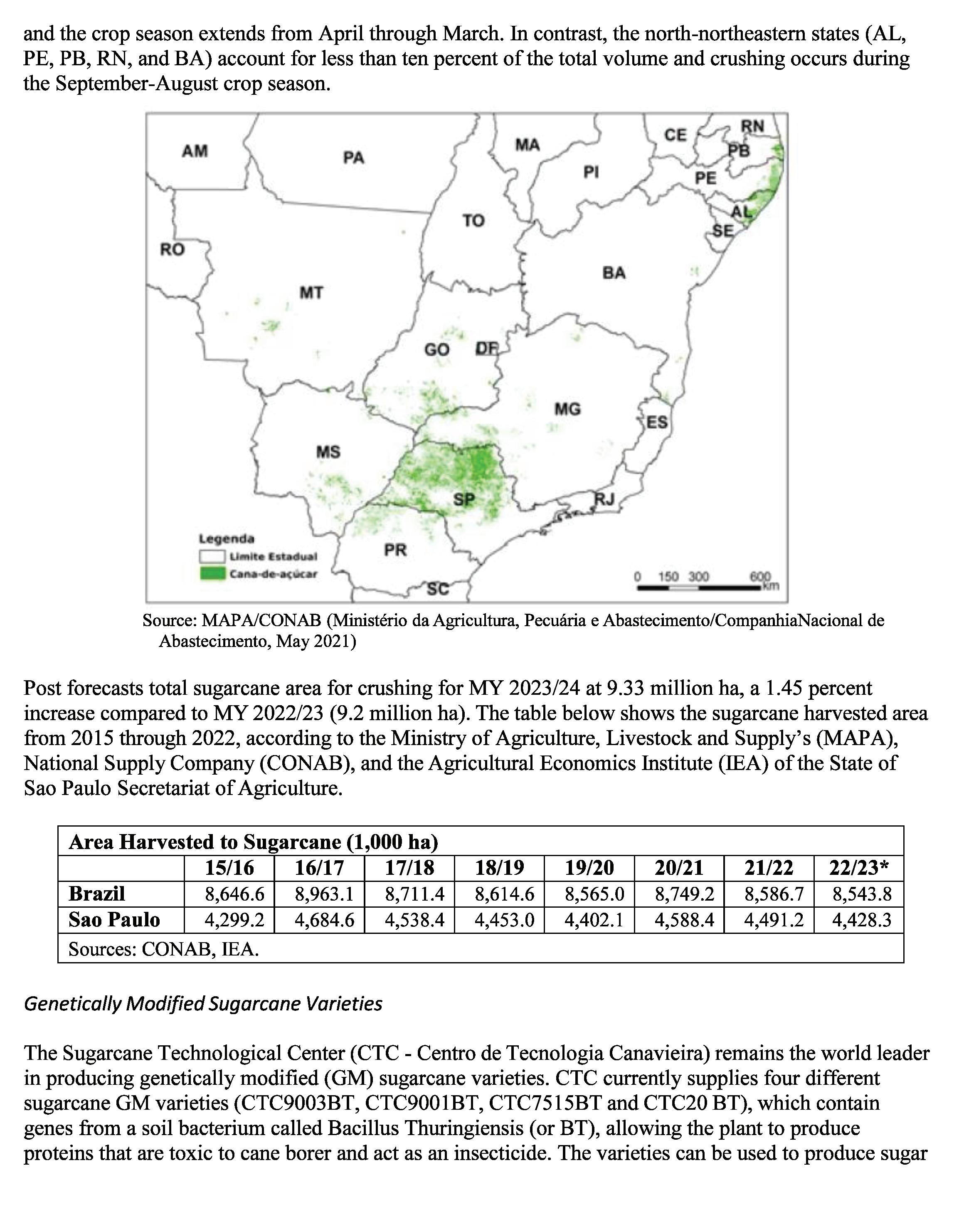
g ot r um? March 2024 - 52

g ot r um? March 2024 - 53

g ot r um? March 2024 - 54

g ot r um? March 2024 - 55

g ot r um? March 2024 - 56

g ot r um? March 2024 - 57

g ot r um? March 2024 - 58

g ot r um? March 2024 - 59
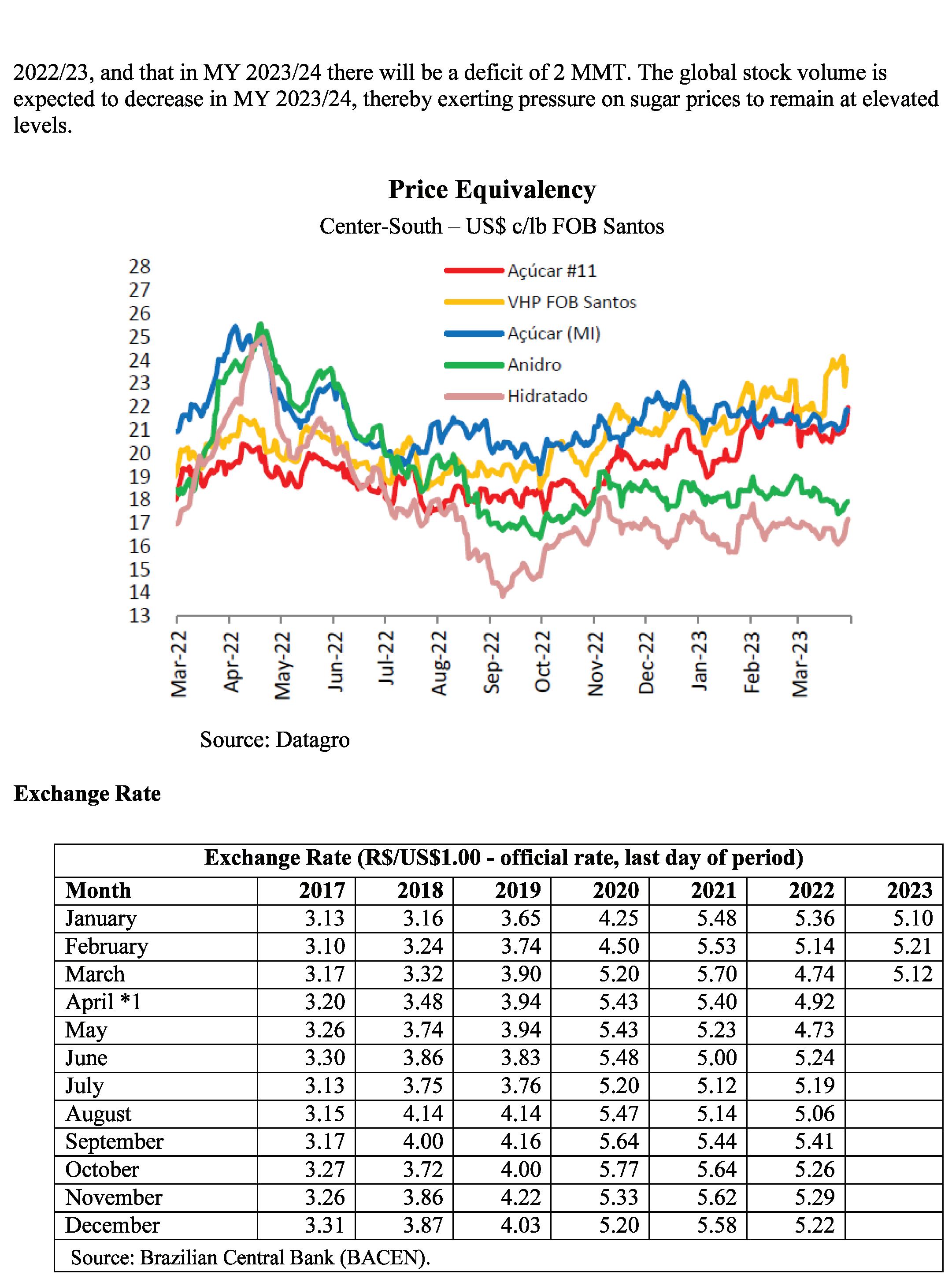
g ot r um? March 2024 - 60

g ot r um? March 2024 - 61

g ot r um? March 2024 - 62

g ot r um? March 2024 - 63
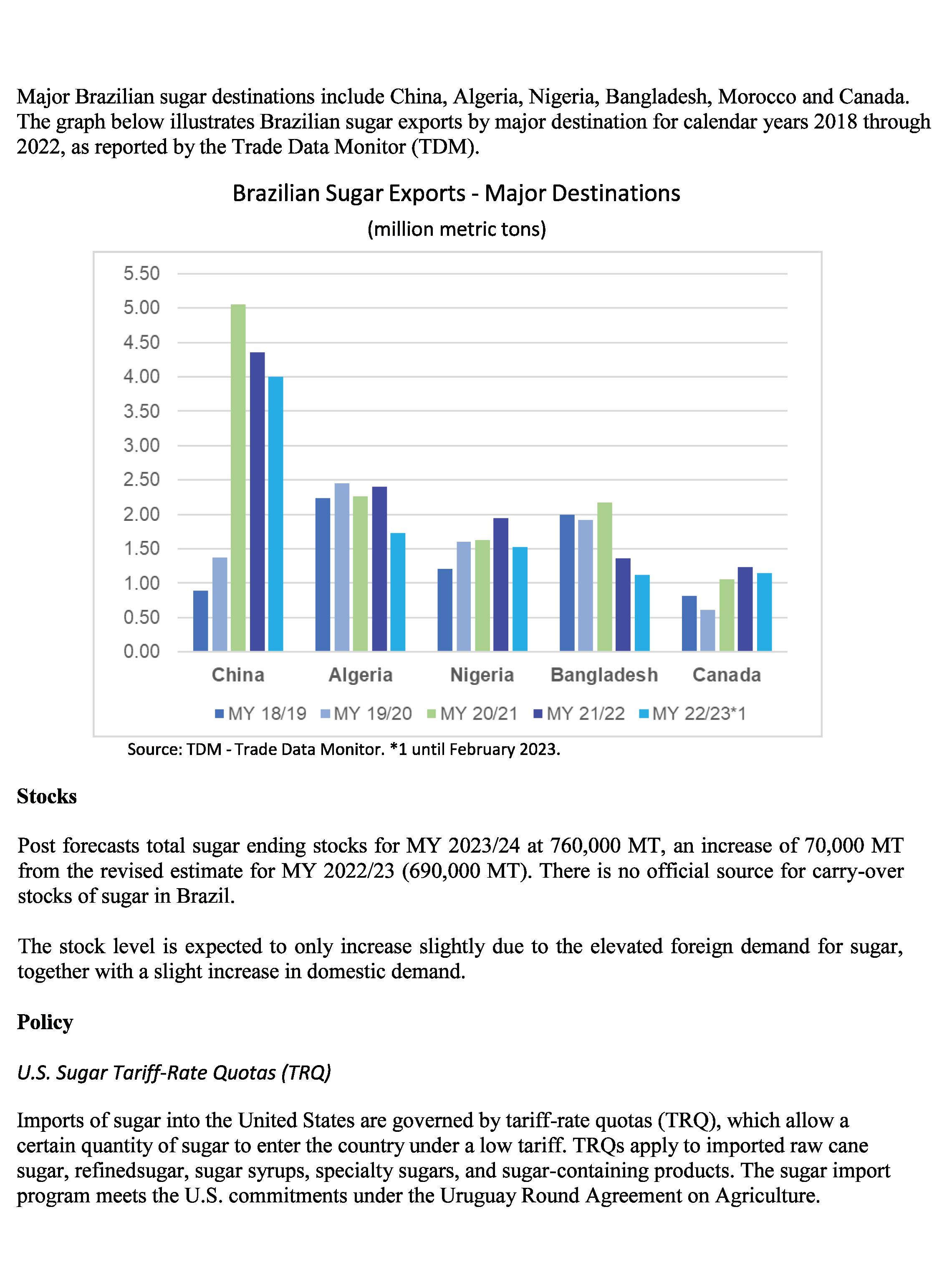
g ot r um? March 2024 - 64

g ot r um? March 2024 - 65

g ot r um? March 2024 - 66

cigar & ru M P airing
by Philip i li Barake
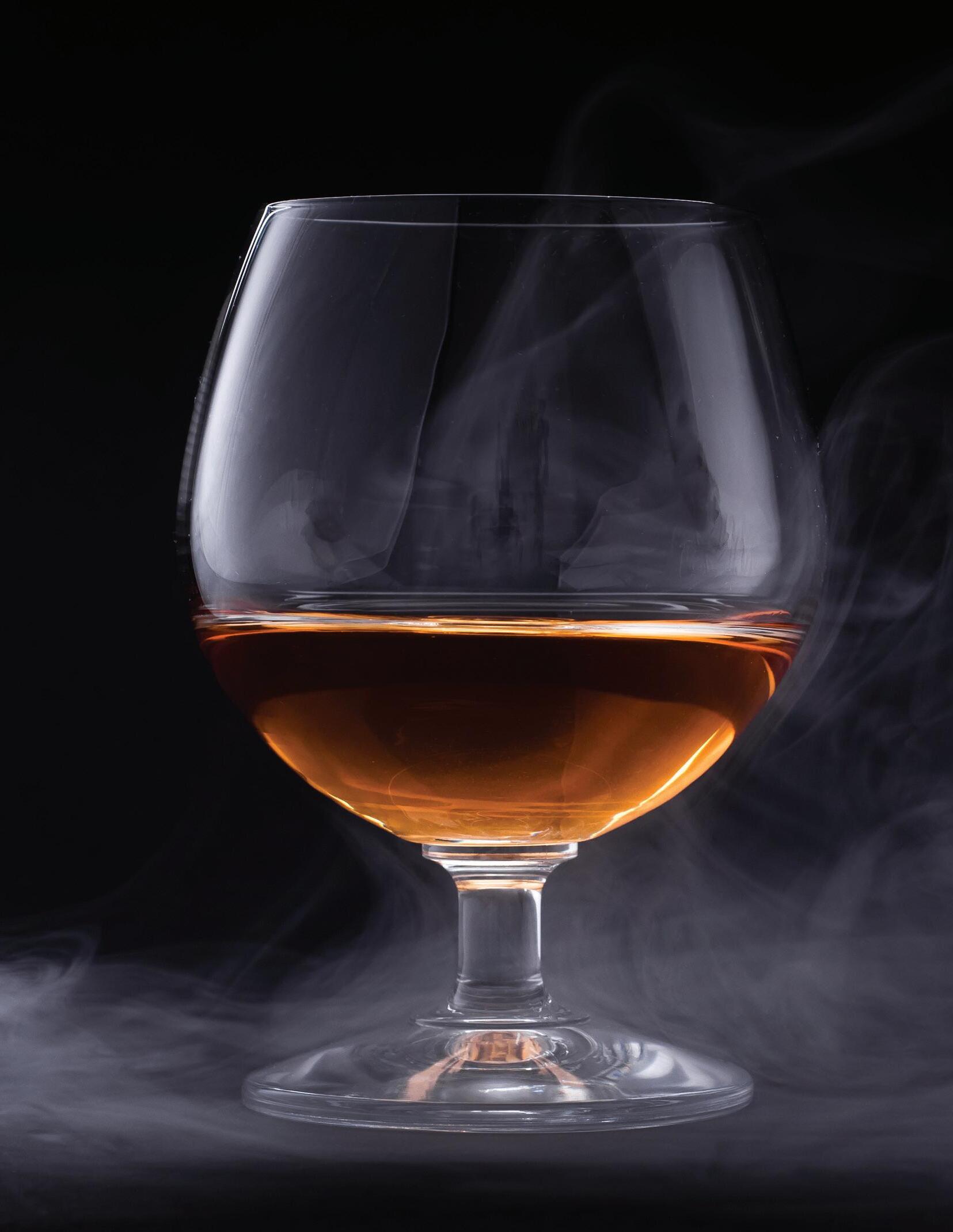


my name is Philip i li Barake, s ommelier by trade. As a result of working with selected restaurants and wine producers in Chile, i started developing a passion for distilled spirits and cigars. As part of my most recent job, i had the opportunity to visit many Central American countries, as well as, rum distilleries and tobacco growers.
But my passion for spirits and cigars did not end there; in 2010 i had the honor of representing Chile at the i nternational Cigar s ommelier Competition, where i won first place, becoming the first s outh American to ever achieve that feat.
n ow i face the challenge of impressing the readers of “ g ot r um?” with what is perhaps the toughest task for a s ommelier: discussing pairings while being well aware that there are as many individual preferences as there are rums and cigars in the world.
i believe a pairing is an experience that should not be limited to only two products; 2024
it is something that can be incorporated into our lives. i hope to help our readers discover and appreciate the pleasure of trying new things (or experiencing known things in new ways).
Philip # gr CigarPairing

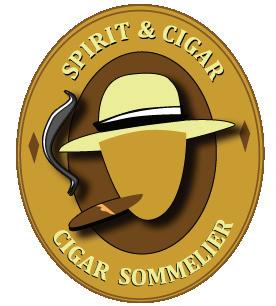
tea r um
As you may remember, in the past i ’ve created classic cocktail recipes using tea, so this is nothing new. This time, however, the ingredients are very easy to replace, so that you can experiment with what you have at home, possibly surpassing the results of my pairing, which i describe below.
i started by selecting a black tea, a classic Ceylon one, something that can easily be found at home. i prepared a standard cup of tea, nothing special, just try not to boil the water. r est the tea in the water for no more than 5 minutes and then place the cup in the refrigerator until it is very cold.
o nce the tea is chilled, we are ready to select the rum. s ince we know that the tea will impart a distinctive bitterness, i took a gamble and opted for a sweetened rum, such as d iplomático or Zacapa 23, both of which would balance this cocktail perfectly.
Finally, to complete the ingredients, i needed a v ermouth r osso, a basic one will work fine, so i grabbed the one we use at the bar, a m artini r osso, but you can easily substitute it with any other v ermouth of similar quality and/or price.
For the cocktail we’ll use a m artini glass, a classic presentation for cocktails where the leading alcohol dominates the profile. i n this glass we’ll attempt to balance the rum with the rest of the ingredients.

g ot r um? March 2024 - 70
Photo credit: @Cigarili
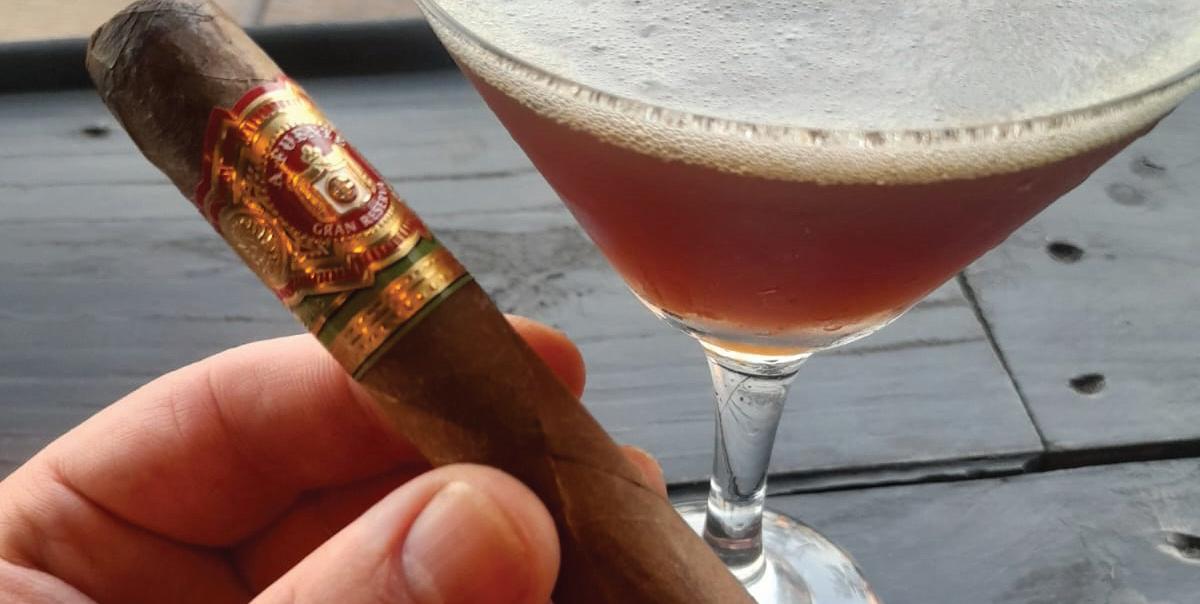
• 3 oz. Zacapa 23
• 3 oz. Ceylon Tea
• 1 oz. v ermouth r osso
Combine all ingredients in a cocktail shaker or in a mixing glass if you don’t have a cocktail shaker. i t is important to keep all ingredients cold, including the m artini glass.
For my cocktail i used an orange peel, since the oils from the orange mix extremely well with the rum.
i t is now time to taste the cocktail and the flavor is amazing, a perfect balance between sweetness and bitterness, that makes the cocktail exceedingly drinkable from the first sips.
n ow we are ready to pair the cocktail with a cigar and i selected a present from a friend of mine who loves all good things in life. h e worked for me during many years but now he is working as a sommelier for many famous stores and restaurants in s antiago.
The cigar was an Arturo Fuente Churchill g ran r eserva (48 x 7 ¼) with natural wrapper and a medium body, which offered us the perfect intensity
for the pairing, without overpowering the flavors. The cigar i selected is a bit long, but i have no problem at all preparing a second cocktail!
i t is possible that by changing some of the ingredients in the cocktail recipe you’ll change the outcome a bit, but as long as the rum is reasonably sweet (avoiding rum liqueurs), you should be able to maintain a good balance. i f the rums you have at hand are not sweet enough, you can sweeten the tea instead, to respect the spirit or the cocktail.
i t takes time to enjoy a good cigar and you’ll cherish every minute of it if you are able to pair it with a well-balanced cocktail that is tailor-made to your own preferences.
i hope that you enjoy this pairing, if it is very cold where you are, please consider substituting the cigar with a much shorter one.
Cheers!
Philip i li Barake # gr CigarPairing
g ot r um? March 2024 - 71
Photo credit: @Cigarili







Transforming your rum ideas into reality! Aged rums in Bulk For Your super Premium Brand! www.rumCentral.com RUM

















 l uis Ayala, Editor and Publisher
l uis Ayala, Editor and Publisher































































































